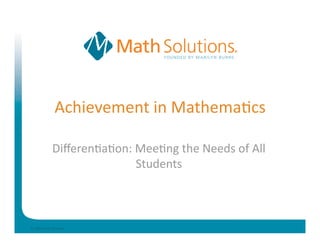Weitere ähnliche Inhalte
Ähnlich wie Differentiation presentation slides (20)
Differentiation presentation slides
- 2. If you are having audio problems, call 484-589-1010, and use access code 310-064-690 #
Presenters
Pa@y Clark, Moderator
Educa.on Consultant
Math Solu.ons
Jayne Bamford Lynch
Na.onal Faculty Lesley University
District math coach K‐8, Cambridge, Massachuse@s
Author Math For All: Differen1a1ng Instruc1on, Grades 3‐5
Liz Stamson
Math specialist
Building math coach
White Bear Lake Schools, Minnesota
© 2009 Math Solu.ons
- 5. Differen.a.ng Instruc.on: What It Is
and How It’s Done
Jayne Bamford Lynch
Na.onal Faculty, Lesley University
District math coach K‐8, Cambridge, Massachuse@s
Author, Math for All: Differen1a1ng Instruc1on,
Grades 3‐5
© 2009 Math Solu.ons
- 8.
Share your strength!
© 2009 Math Solu.ons
- 10. What is Differen.ated Instruc.on?
Differen.ated instruc.on is instruc.on
that is designed to meet the needs of
differing learners and increase the
likelihood that all students will succeed
and meet required curricular
outcomes.
© 2009 Math Solu.ons
- 12. Choices to Offer Students
• Which tasks to complete
• What materials to use
• With whom to partner
• Where to work
• How long to work on a par.cular task
• Which topics to study
• The order in which to complete assignments
• How to represent and present ideas
• How to demonstrate what is understood
© 2009 Math Solu.ons
- 13. Example Ques.onnaire: Who Are
You as a Learner?
From Math for All: Differentiating
Instruction, Grades 3–5 by Linda Dacey
and Jayne Bamford Lynch. © 2007
Math Solutions Publications.
© 2009 Math Solu.ons
- 14. Menus
Appe%zer (Chose One)
Make a circle and stars book
Play Mul.plica.on Tic Tac Toe
Main Course (Must Do)
Solve the problem, write a mul%plica%on
equa%on and show your solu%on.
Jack drew some hexagons.
Each hexagon has 6 sides.
There are 30 sides in all.
How many hexagons did Jack draw?
Dessert (Chose One)
Write a song to help you remember you
mul.plica.on facts
Read a book about mul.plica.on from the
basket
© 2009 Math Solu.ons
- 15. Suppor.ng Choice: Think
Tac Toe
From Math for All: Differentiating Instruction, Grades 3–5 by Linda Dacey and Jayne
Bamford Lynch. © 2007 Math Solutions Publications.
© 2009 Math Solu.ons
- 17. Teaching With the Goal of
Differen.a.on: 10 Ways to Sustain
Your Efforts
1. Iden.fy where you already provide differen.a.on
2. Recognize where you are along the journey
3. Get support with what you want to learn
4. Share your strengths
5. Give students choice
6. Work with parents
7. Find sources of professional development
8. Reflect on your journey
9. Keep the vision
10. Feel part of a bigger mission
© 2009 Math Solu.ons
- 18. Differen.a.ng in Ac.on
Liz Stamson
Math specialist
Building math coach
White Bear Lake Schools, Minnesota
© 2009 Math Solu.ons
- 20. Engaging Our Community of
Educators
• Team teacher
• Groups of teachers
• Forma.on of teachers into a PLC focused on
differen.a.on in math
• Principal encouraged and funded PD efforts
© 2009 Math Solu.ons
- 22. Trying Different Strategies
• Asking ques.ons that require more thought
than a yes/no ques.on
How did you solve the problem?
How is your strategy like ______’s strategy?
Why does your strategy work?
Do you think your strategy will always work?
© 2009 Math Solu.ons
- 24. RAFT
From Math for All: Differentiating Instruction, Grades 3–5 by Linda Dacey and Jayne
Bamford Lynch. © 2007 Math Solutions Publications.
© 2009 Math Solu.ons
- 25. Benefits of Differen.a.on
• Student engagement
• Student response
• Student par.cipa.on
• Parents changes
• Achievement
© 2009 Math Solu.ons
- 26. Lessons Learned
• Start with one differen.a.on strategy
• Brainstorm with other teachers
• Do what works
• Listen to student feedback
© 2009 Math Solu.ons
- 27. Math Solu.ons Support for
Differen.ated Instruc.on
• Immersion Courses, School Year Courses, and
School Based Coaching
• Math Solu.ons Publica.ons
© 2009 Math Solu.ons
- 28. Ques.on & Answer
Pa@y Clark, Moderator
Educa.on Consultant
Math Solu.ons
Jayne Bamford Lynch
Na.onal Faculty Lesley University
District math coach K‐8, Cambridge, Massachuse@s
Author Math For All: Differen1a1ng Instruc1on, Grades 3‐5
Liz Stamson
Math specialist
Building math coach
White Bear Lake Schools, Minnesota
© 2009 Math Solu.ons
